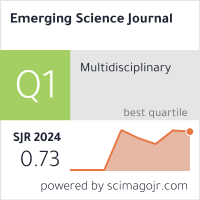E-Learning Integration and Its Impact on MIS Skill Development and Student Engagement
Downloads
Doi:10.28991/ESJ-2024-SIED1-025
Full Text:PDF
Downloads
Nadella, G. S., Meduri, K., Satish, S., Maturi, M. H., & Gonaygunta, H. (2024). Examining E-learning tools impact using IS-impact model: A comparative PLS-SEM and IPMA case study. Journal of Open Innovation: Technology, Market, and Complexity, 10(3), 100351. doi:10.1016/j.joitmc.2024.100351.
Maqbool, M. A., Asif, M., Imran, M., Bibi, S., & Almusharraf, N. (2024). Emerging E-learning trends: A study of faculty perceptions and impact of collaborative techniques using fuzzy interface system. Social Sciences and Humanities Open, 10, 101035. doi:10.1016/j.ssaho.2024.101035.
Levidze, M. (2024). Mapping the research landscape: A bibliometric analysis of e-learning during the COVID-19 pandemic. Heliyon, 10(13), 33875. doi:10.1016/j.heliyon.2024.e33875.
Al-Sartawi, A., & Hannoon, A. (2024). E-learning and the Future of Business Education: The Case of GCC. In A. M. A. M. Al-Sartawi & A. I. Nour (Eds.), Studies in Systems, Decision and Control (Vol. 528, pp. 939–943). Springer Nature Switzerland. doi:10.1007/978-3-031-56586-1_67.
Kinuthia, H. (2024). The recontextualisation and cultural compatibility of student-centred education: the case of the United Arab Emirates. Higher Education, 87(4), 1009–1026. doi:10.1007/s10734-023-01049-1.
Alemu, B. S., Gameda, B. I., & Zeleke, B. (2024). The Effects of Internationalization of Higher Education on Ethiopian Public Universities: A Critical Review of Literature. Ethiopian Journal of Science and Sustainable Development, 11(2), 38–50.
Karanikola, Z. (2025). Fostering Global Competence in Higher Education: Undergraduate Students' Insights. In International Academic Transformations and Cross-Border Collaborations, 249-276. doi:10.4018/979-8-3373-0508-0.ch011.
Doulougeri, K., Vermunt, J. D., Bombaerts, G., & Bots, M. (2024). Challenge-based learning implementation in engineering education: A systematic literature review. Journal of Engineering Education, 113(4), 1076–1106,. doi:10.1002/jee.20588.
Alfahel, E., Daher, W., & Anabousy, A. (2023). Students' motivation to study science: The case of Arab students in Israel. Eurasia Journal of Mathematics, Science and Technology Education, 19(7), 2291. doi:10.29333/ejmste/13299.
Shannaq, B., Adebiaye, R., Owusu, T., & Al-Zeidi, A. (2024). An intelligent online human-computer interaction tool for adapting educational content to diverse learning capabilities across Arab cultures: Challenges and strategies. Journal of Infrastructure, Policy and Development, 8(9), 7172. doi:10.24294/jipd.v8i9.7172.
Faria, A. T., Das, L. C., Bhattacharjee, H., & Tamim, M. A. A. (2024). Exploring the future of edtech and the COVID-19 impact on digital learning in Bangladesh: A predictive analysis using EDA and regression analysis. American Journal of Education and Learning, 9(1), 104–125. doi:10.55284/ajel.v9i1.1139.
Shannaq, B. (2024). Unveiling the Nexus: Exploring TAM Components Influencing Professors' Satisfaction With Smartphone Integration in Lectures: A Case Study From Oman. TEM Journal, 2365–2375. doi:10.18421/tem133-63.
Shannaq, B., Shakir, M., Al maqbali, S., Shukaili, H. al, & Ail, F. (2024). Evaluating the future of digital and Face-to-Face Communication on student motivation: Implications for human resource roles in AI-driven Oman higher education. Journal of Infrastructure, Policy and Development, 8(15), 9655. doi:10.24294/jipd9655.
Arai, K. (2022). Advances in Information and Communication: Proceedings of the 2022 Future of Information and Communication Conference (FICC), Volume 2, 439. doi:10.1007/978-3-031-54053-0.
Shakir, M., Farsi, M. J. Al, Al-Shamsi, I. R., Shannaq, B., & Taufiq-Hail, G. A. M. (2024). The Influence of Mobile Information Systems Implementation on Enhancing Human Resource Performance Skills: An Applied Study in a Small Organization. International Journal of Interactive Mobile Technologies, 18(13), 37–68. doi:10.3991/ijim.v18i13.47027.
Alshamsi, I., Sadriwala, K. F., Alazzawi, F. J. I., & Shannaq, B. (2024). Exploring the impact of generative AI technologies on education: Academic expert perspectives, trends, and implications for sustainable development goals. Journal of Infrastructure, Policy and Development, 8(11), 8532. doi:10.24294/jipd.v8i11.8532.
Shannaq, B., Muniyanayaka, D. K., Ali, O., Bani-Ismail, B., & Al Maqbali, S. (2024). Exploring the role of machine learning models in risk assessment models for developed organizations' management decision policies. Journal of Infrastructure, Policy and Development, 8(13), 9364. doi:10.24294/jipd9364.
Awwad, B. (2024). The AI Revolution: Driving Business Innovation and Research. Studies in Systems, Decision and Control, 2, 525.. doi:10.1007/978-3-031-54383-8.
Hoi, V. N., & Le Hang, H. (2021). The structure of student engagement in online learning: A bi-factor exploratory structural equation modelling approach. Journal of Computer Assisted Learning, 37(4), 1141–1153. doi:10.1111/jcal.12551.
Sulaiman, T. T. (2024). A systematic review on factors influencing learning management system usage in Arab gulf countries. Education and Information Technologies, 29(2), 2503–2521. doi:10.1007/s10639-023-11936-w.
Adeniyi, I. S., Al Hamad, N. M., Adewusi, O. E., Unachukwu, C. C., Osawaru, B., Onyebuchi, C. N., ... & David, I. O. (2024). E-learning platforms in higher education: A comparative review of the USA and Africa. International Journal of Science and Research Archive, 11(1), 1686-1697. doi:10.30574/ijsra.2024.11.1.0283.
Segumpan, R. G., & McAlaney, J. (2023). Challenges and Reforms in Gulf Higher Education: Confronting the COVID-19 Pandemic and Assessing Future Implications. Routledge, New York, United States. doi:10.4324/9781003457299.
Mensah Minadzi, V., & Segbenya, M. (2024). Usefulness and challenges with blended learning during the COVID-19 pandemic in Ghana: The mediating role of human resource factors. Computers in Human Behavior Reports, 16, 100468. doi:10.1016/j.chbr.2024.100468.
Al Arif, T. Z. Z., Kurniawan, D., Handayani, R., Hidayati, & Armiwati. (2024). EFL University Students' Acceptance and Readiness for e-Learning: A Structural Equation Modeling Approach. Electronic Journal of E-Learning, 22(1), 1–16. doi:10.34190/ejel.22.1.3063.
Konyani, B., Katanga, P., Chiundira, F., Mulenga, C., & Mapulanga, P. (2024). E-learning preparedness of nursing students at Kamuzu University of Health Sciences in Malawi. Education and Information Technologies. doi:10.1007/s10639-024-12930-6.
Wagino, W., Maksum, H., Purwanto, W., Simatupang, W., Lapisa, R., & Indrawan, E. (2024). Enhancing Learning Outcomes and Student Engagement: Integrating E-Learning Innovations into Problem-Based Higher Education. International Journal of Interactive Mobile Technologies, 18(10), 106–124. doi:10.3991/ijim.v18i10.47649.
Wu, R., & Yu, Z. (2024). Relationship between university students' personalities and e-learning engagement mediated by achievement emotions and adaptability. Education and Information Technologies, 29(9), 10821–10850. doi:10.1007/s10639-023-12222-5.
Yi, S., Zhang, Y., Lu, Y., & Shadiev, R. (2024). Sense of belonging, academic self-efficacy and hardiness: Their impacts on student engagement in distance learning courses. British Journal of Educational Technology, 55(4), 1703–1727. doi:10.1111/bjet.13421.
Aldhaen, E. (2024). The influence of digital competence of academicians on students' engagement at university level: moderating effect of the pandemic outbreak. Competitiveness Review, 34(1), 51–71. doi:10.1108/CR-01-2023-0008.
Muasyaroh, H., & Royanto, L. (2024). Digital literacy, attitudes toward e-learning, and task value roles in college students' distance learning self-regulation. Psychological Research on Urban Society, 7(1). doi:10.7454/proust.v7i1.1156.
Mughal, I., Mughal, D. D. K., Shaikh, H. R., & Hussain, F. ul. (2024). Analyzing the Nexus of Institutional and Individual Factors on Students' Willingness for Online Learning among Universities Students. Pakistan Journal of Humanities and Social Sciences, 12(2), 2126–2146. doi:10.52131/pjhss.2024.v12i2.2276.
Armah, E. D., & Sathik Ali, I. (2024). Navigating Anxiety in a Cloud E-learning Virtual Environments: The Moderating Role of Anxiety on Lecturers' Adoption of Cloud Computing E-learning. International Journal of Interactive Mobile Technologies , 18(17), 115–138. doi:10.3991/ijim.v18i17.49661.
Sharif-Nia, H., Allen, K. A., Arslan, G., Reardon, J., She, L., Ghahrani, N., Rahmatpour, P., & Fomani, F. K. (2024). E-learning Acceptance: The Mediating Role of Student Computer Competency in the Relationship Between the Instructor and the Educational Content. Teaching and Learning in Nursing, 19(1), e5–e10. doi:10.1016/j.teln.2023.08.001.
El-Gazar, H. E., Zoromba, M. A., Fayed, S. M., Loutfy, A., Elzieny, A. A., Elzeiny, A., Alkubati, S. A., Shahin, M. A. H., Altheeb, M., & El-Monshed, A. H. (2024). Nurturing Success: E-Learning readiness and academic self-efficacy in nursing students. BMC Nursing, 23(1), 495. doi:10.1186/s12912-024-02125-2.
Alanazi, A., Binti Elias, N. F., Mohamed, H. B., & Sahari, N. (2024). The critical success factors influencing the use of mobile learning and its perceived impacts in students education: A systematic literature review. KSII Transactions on Internet and Information Systems, 18(3), 610–632. doi:10.3837/tiis.2024.03.005.
Al-Maroof, R. S., Alhumaid, K., Alshaafi, A., Akour, I., Bettayeb, A., Alfaisal, R., & Salloum, S. A. (2024). A Comparative Analysis of ChatGPT and Google in Educational Settings: Understanding the Influence of Mediators on Learning Platform Adoption. Studies in Big Data, 144, 365–386. doi:10.1007/978-3-031-52280-2_23.
Dwivedi, P. B., Ghazali, M. Al, Balushi, N. Al, Batool, A., Al Balushi, J. M. S., & Nalankilli, C. (2024). Preparedness, Resilience, and Sustainability for Pedagogical Success at the National University of Science & Technology, Oman during the COVID-19 and Lessons for the Future. International Journal of Learning, Teaching and Educational Research, 23(5), 257–283. doi:10.26803/ijlter.23.5.14.
Al-Mamari, H. S. M., Kumar, J. A., & Bervell, B. (2024). Moocs Adoption Among Omani Faculty Members: Investigating the Effects of Gender and Faculty Disciplines on Readiness. Journal of Educators Online, 21(3). doi:10.9743/JEO.2024.21.3.10.
Hair, J. F., Risher, J. J., Sarstedt, M., & Ringle, C. M. (2019). When to use and how to report the results of PLS-SEM. European Business Review, 31(1), 2–24. doi:10.1108/EBR-11-2018-0203.
Hair, J. F., L.D.S. Gabriel, M., da Silva, D., & Braga Junior, S. (2019). Development and validation of attitudes measurement scales: fundamental and practical aspects. RAUSP Management Journal, 54(4), 490–507. doi:10.1108/RAUSP-05-2019-0098.
Sarstedt, M., & Christian M. Ringle, and J. F. H. (2017). Partial least squares structural equation modeling with R. Practical Assessment, Research and Evaluation, 21(1), 1–16. doi:10.1007/978-3-030-80519-7.
- This work (including HTML and PDF Files) is licensed under a Creative Commons Attribution 4.0 International License.




















